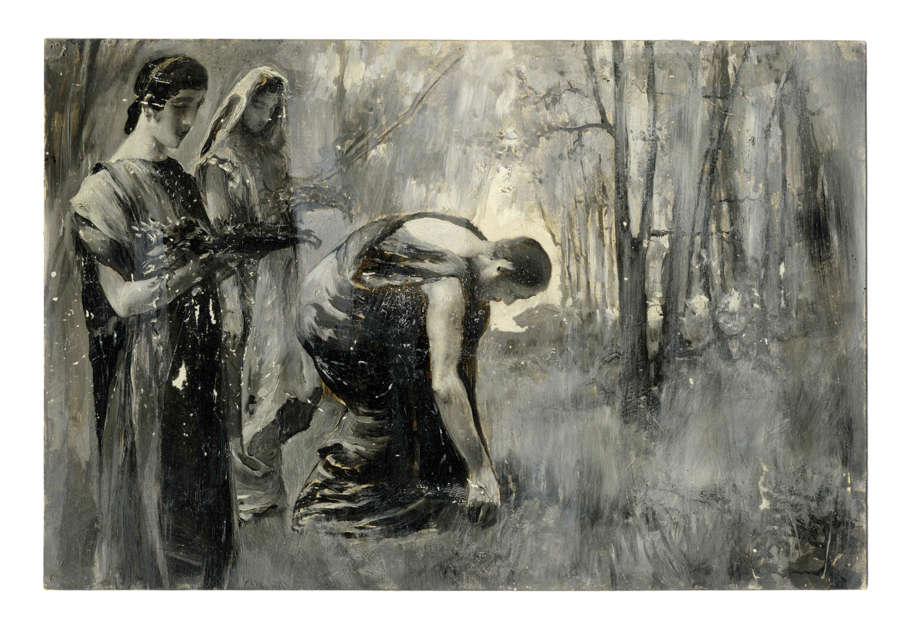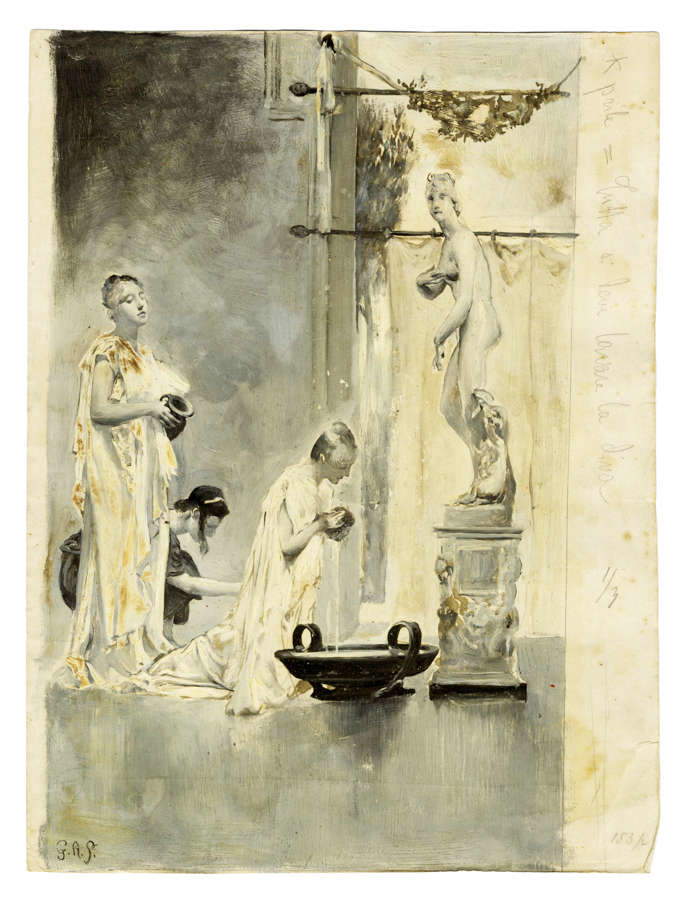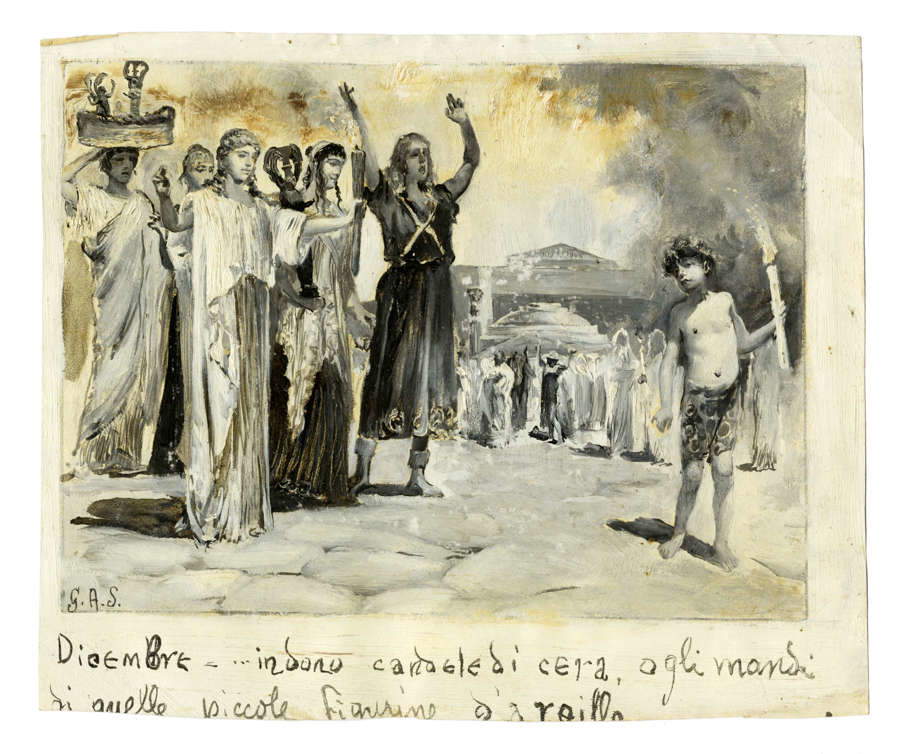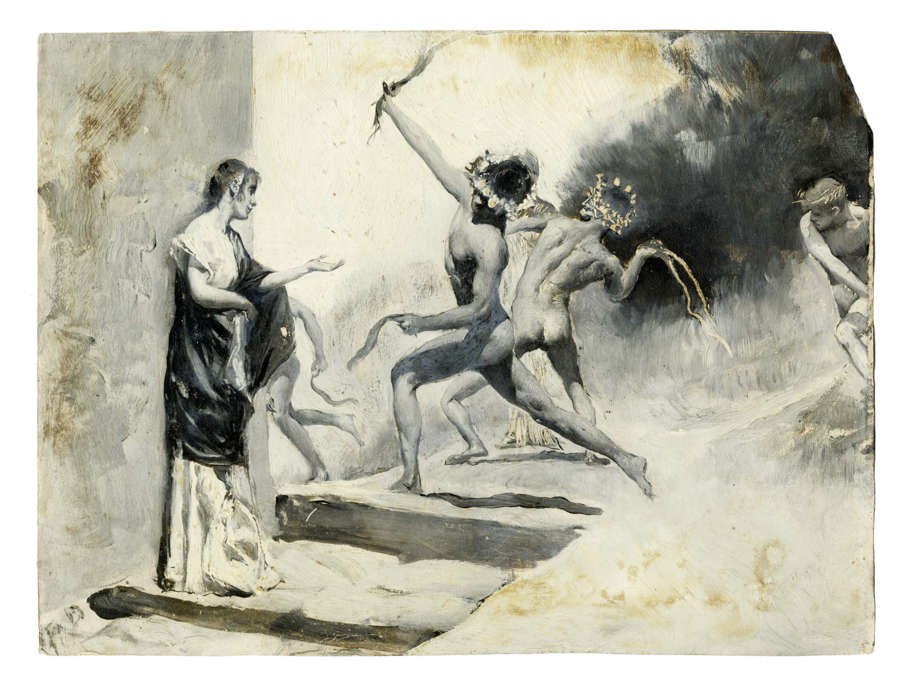From May 8-31, 2024, the tempera drawings executed by Roman painter Giulio Aristide Sartorio (Rome, 1860-1932) to illustrate Ruggero Bonghi’s Le feste romane, published in Milan by Hoepli in 1891, will be on display at the Gonnelli Bookshop-Auction House-Art House in Florence. The nucleus of 32 drawings will be auctioned off during the spring auction of ancient, modern and contemporary graphics scheduled for May 14-15-16. The book by Bonghi, a distinguished Italian politician and man of letters, deputy and minister of education during the Minghetti government, offers a detailed description, divided by each month of the year, of ancient Roman religious festivals and celebrations such as the Saturnalia, Lupercali, Calende, and many others from the founding of Rome to the end of the Roman Empire. The title page states that the illustrations were done by Ugo Fleres and Giulio Aristide Sartorio. However, this work by Sartorio seems to have escaped top experts until now, perhaps because it was considered to be of lesser importance than both his earlier “Byzantine” contribution toD’Annunzio’s Editio picta of Isaotta Guttadauro (1886) and other more mature and significant works such as Christus and Sibilla from several years later.
In 1889 the artist had embarked on a trip to Paris accompanied by Francesco Paolo Michetti, who had introduced him to the landscape painting of the Barbizon school, with the aim of opening new horizons for him to overcome the formalism of the academic and pompier culture by which he was still partly conditioned. In the following year, during Michetti’s Abruzzese sojourn as a guest in Francavilla a Mare, Sartorio was urged by his friend to portray glimpses of the countryside from life, and a series of long, narrow pastels with a lowered horizon was born, the characteristic cut of which can also be found in some of the illustrations for the mastheads of the Feste romane. Two of the illustrations for the larger plates turn out to be executed on the verso of fragments of the advertising poster for the bitter Corfinium made with herbs from Gran Sasso and Maiella. Michetti had conceived the design with Greek vascular figures for the bottle label and it was probably up to him to execute the poster as well, although it is not signed. Therefore, this coincidence suggests that the illustrations for Le feste romane were made by Sartorio precisely in Francavilla in close proximity to the Abruzzese painter. The illustrations outside the text also include some particularly important elements, such as in the panel depicting the quirinal flamen and the vestal virgins in which appears, perhaps for the first time, the statue of Artemis Ephesia preserved in theNational Archaeological Museum in Naples, a particularly significant symbolic topos that Sartorio placed at the center of the painting entitled Men and Chimaeras, a large canvas over eight meters long, modeled on the earlier work The Children of Cain awarded in Paris in 1889. According to Ugo Fleres’ own description of it in 1890, this first version depicted the Diana of Ephesus as a primitive idol surrounded by naked men and women immersed in sleep.
Sartorio then remade in Weimar the famous painting Diana of Ephesus and the Slaves completed in 1899 and now in the National Gallery of Modern Art in Rome. In the panel of the Latin women performing the ritual of washing the statue of Venus, the female figure on the left with a vase in her hands is found in an almost palpable way, again on the far left, in the triptych The Sage Virgins and the Foolish Virgins commissioned from Sartorio by Count Primoli in 1890 and of which it may constitute the antecedent. The processional theory of virgins bearing garlands for the Feast of Flora outlined in another panel in the book also reveals some similarities with the aforementioned triptych. The Roman Feasts are particularly imbued with the sacred aura of the ancient classical world, congenial to the antiquarian passion of the artist, who frequented museums and was passionate about Greco-Roman history and archaeology. Again Ugo Fleres defined at that time the artist friend as a “wise chooser, happy assimilator, rich in a wealth of images and notions that make him paint rather with aristocratic delight, rather than with frank emotion” (U. Fleres, Prima esposizione della città di Roma, in “Archivio Storico dell’Arte,” V-VI, 1890, p. 243). The same grisaille technique of the original tempera illustrations foreshadowed an aesthetic choice that Sartorio applied several years later to large decorative panels such as the Latium Hall Frieze, created in 1906 for theSimplon International Exhibition.




In addition to the exhibition will be rare proofs for Christus, later published in Fausto Salvadori’s volume of the same name published in a deluxe edition in 1932. Two large plates belonging to this nucleus (also presented at auction) are dated 1912 and show that at that date Sartorio was already working on the illustrative project, in parallel with that for the drama Sibyl. In both works Sartorio adopted the same technique, namely relief etchings on zinc that when printed gave the effect of woodcuts. The transposition to relief on zinc with xylographic effect of the pen outlines allowed the artist the simplification of the images in the two-dimensional relationship of black and white, and his photographic passion contributed to the new compositional cut of many of the representations, which was useful in enhancing the dramatic character of the scenes. Also on display will be the complete volume of Sibyl published by “L’Eroica” in 1922 and the two issues of the La Spezia magazine where the first essays of the illustrations first appeared (1912-1913). Also exhibited are etchings and ex libris made by the artist for Gabriele d’Annunzio and himself.
 |
| Florence, on display the sacred aura of Giulio Aristide Sartorio's Roman Feasts. Then they will be sold |
Warning: the translation into English of the original Italian article was created using automatic tools. We undertake to review all articles, but we do not guarantee the total absence of inaccuracies in the translation due to the program. You can find the original by clicking on the ITA button. If you find any mistake,please contact us.